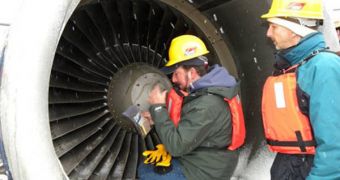At the beginning of this year, an airplane was forced to make an emergency landing in the waters of the Hudson river in New York. The pilot managed to land the plane safely on the water, after a flock of birds hit one of its engines, forcing it to shut down. Now, using a sophisticated chemical analysis, experts have finally managed to identify what kind of birds those were, ScienceNow reports.
The accident took place on January 15th, after Flight 1549 had just taken off from the LaGuardia Airport. Shortly after the plane separated from the ground, a flock of birds flew in the path of the aircraft and entered its engines, wreaking havoc inside. Responding to the emergency, the pilot managed to land the plane safely, in what was considered to be a very difficult circumstance.
After the crash, investigators collected more than 100 samples of feathers and other organic remains from the engines and the fuselage of the flight, and sent them to the Smithsonian Institution's Feather Identification Lab (FIL), in Washington, DC, for a thorough analysis. Such planes usually come unharmed when they meet small birds, but experts first thought it had hit large waterfowl, which are simply too big not to cause any damage.
In their strife to identify the culprit, FIL experts, led by Carla Dove, sequenced a small piece of mitochondrial DNA, which is known in the field as a “barcode.” Upon receiving the results, she cross-referenced them to a large database, containing similar barcodes from numerous bird species around the globe. Using this method, she learned that Canada geese were the actual culprits behind the accident, one of the two species that were originally held responsible for Flight 1549's crash.
According to statistics, more than 7,400 bird strikes were reported in the United States in 2007 alone. Since 1988, global reports indicate that in excess of 210 airplanes were destroyed or heavily damaged after running into various types of birds, with the accidents resulting in some 230 deaths. These incidents create more than $1.1 billion in damage each year, statistics further show.

 14 DAY TRIAL //
14 DAY TRIAL //